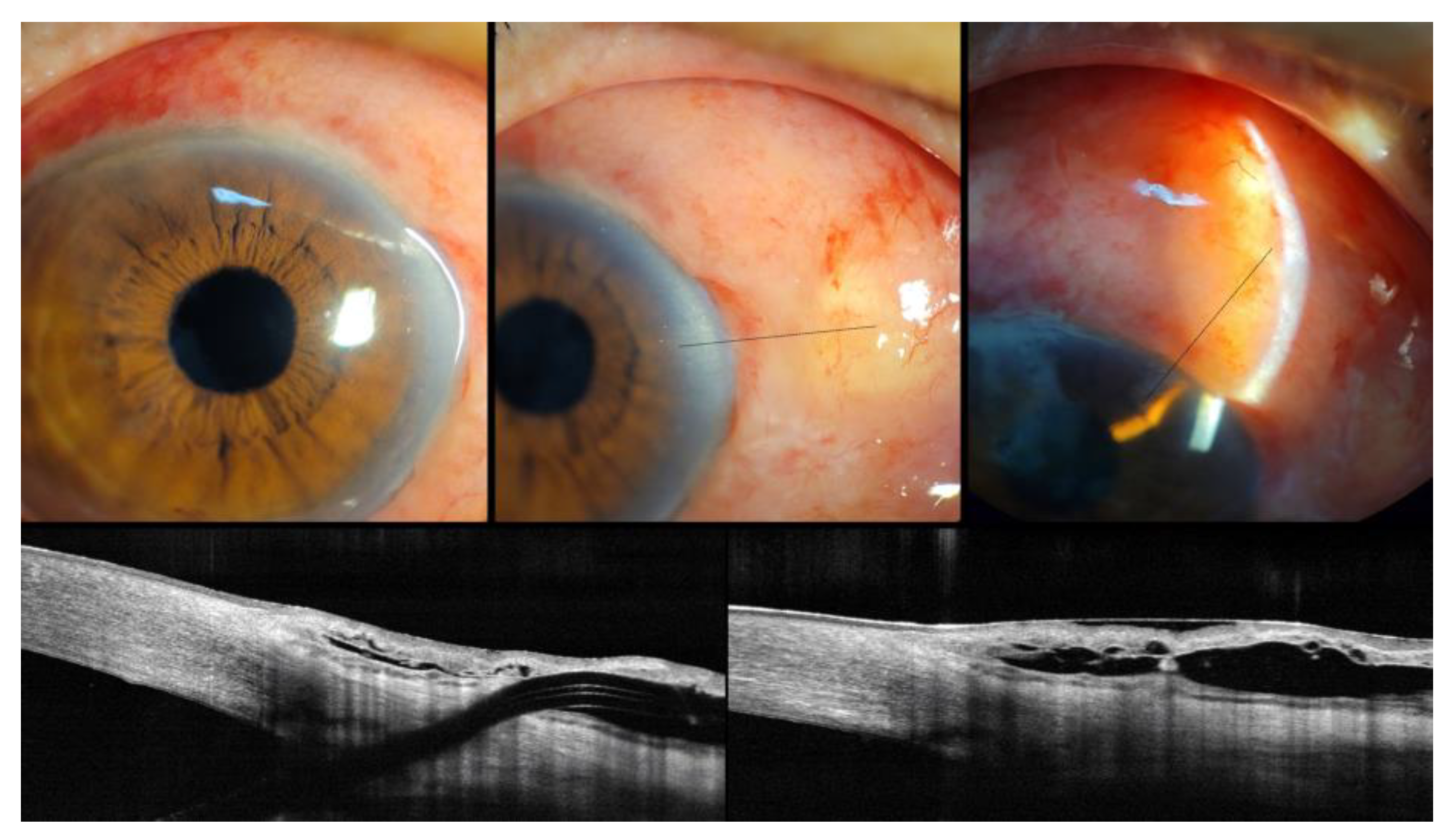Management of XEN Gel Stent Exposure with Conjunctival Erosion via Rotational Conjunctival Flap and Amniotic Membrane Transplantation—A Case Report
Abstract
:1. Introduction
2. Case Presentation
2.1. Initial Presentation
2.2. The Surgical Procedure for Initial XEN Gel Stent Implantation
2.3. XEN Gel Stent Exposure with Conjunctival Erosion
3. Management and Outcomes
3.1. Management for XEN Gel Stent Exposure with Conjunctival Erosion
3.2. Surgical Outcomes
4. Discussion
5. Conclusions
Author Contributions
Funding
Institutional Review Board Statement
Informed Consent Statement
Data Availability Statement
Acknowledgments
Conflicts of Interest
References
- Chaudhary, A.; Salinas, L.; Guidotti, J.; Mermoud, A.; Mansouri, K. XEN Gel Implant: A new surgical approach in glaucoma. Expert Rev. Med. Devices 2018, 15, 47–59. [Google Scholar] [CrossRef] [PubMed]
- De Gregorio, A.; Pedrotti, E.; Stevan, G.; Bertoncello, A.; Morselli, S. XEN glaucoma treatment system in the management of refractory glaucomas: A short review on trial data and potential role in clinical practice. Clin. Ophthalmol. 2018, 12, 773–782. [Google Scholar] [CrossRef] [PubMed] [Green Version]
- Sng, C.B.K. Minimally Invasive Glaucoma Surgery. 2021. Available online: https://assileye.com/surgery/minimally-invasive-glaucoma-surgery (accessed on 1 October 2022).
- Gupta, D.; Muir, K.; Herndon, L., Jr. The Duke Manual of Glaucoma Surgery; LWW: Philadelphia, PA, USA, 2022. [Google Scholar]
- Arnould, L.; Theillac, V.; Moran, S.; Gatinel, D.; Grise-Dulac, A. Recurrent Exposure of XEN Gel Stent Implant and Conjunctival Erosion. J. Glaucoma 2019, 28, e37–e40. [Google Scholar] [CrossRef] [PubMed]
- Lapira, M.; Cronbach, N.; Shaikh, A. Extrusion and Breakage of XEN Gel Stent Resulting in Endophthalmitis. J. Glaucoma 2018, 27, 934–935. [Google Scholar] [CrossRef] [PubMed]
- Karri, B.; Gupta, C.; Mathews, D. Endophthalmitis Following XEN Stent Exposure. J. Glaucoma 2018, 27, 931–933. [Google Scholar] [CrossRef] [PubMed]
- Kingston, E.J.; Zagora, S.L.; Symes, R.J.; Raman, P.; McCluskey, P.J.; Lusthaus, J.A. Infective Necrotizing Scleritis After XEN Gel Stent With Mitomycin-C. J. Glaucoma 2022, 31, 129–132. [Google Scholar] [CrossRef] [PubMed]
- Santamaria-Alvarez, J.F.; Lillo-Sopena, J.; Sanz-Moreno, S.; Caminal-Mitjana, J.M. Management of Conjunctival Perforation and XEN Gel Stent Exposure by Stent Repositioning Through the Anterior Chamber. J. Glaucoma 2019, 28, e24–e26. [Google Scholar] [CrossRef] [PubMed]
- Tannenbaum, D.P.; Hoffman, D.; Greaney, M.J.; Caprioli, J. Outcomes of bleb excision and conjunctival advancement for leaking or hypotonous eyes after glaucoma filtering surgery. Br. J. Ophthalmol. 2004, 88, 99–103. [Google Scholar] [CrossRef] [PubMed] [Green Version]
- Liu, J.; Sheha, H.; Fu, Y.; Liang, L.; Tseng, S.C. Update on amniotic membrane transplantation. Expert Rev. Ophthalmol. 2010, 5, 645–661. [Google Scholar] [CrossRef]





Publisher’s Note: MDPI stays neutral with regard to jurisdictional claims in published maps and institutional affiliations. |
© 2022 by the authors. Licensee MDPI, Basel, Switzerland. This article is an open access article distributed under the terms and conditions of the Creative Commons Attribution (CC BY) license (https://creativecommons.org/licenses/by/4.0/).
Share and Cite
Lee, C.K.; Seo, J.H.; Lim, S.-H. Management of XEN Gel Stent Exposure with Conjunctival Erosion via Rotational Conjunctival Flap and Amniotic Membrane Transplantation—A Case Report. Medicina 2022, 58, 1581. https://doi.org/10.3390/medicina58111581
Lee CK, Seo JH, Lim S-H. Management of XEN Gel Stent Exposure with Conjunctival Erosion via Rotational Conjunctival Flap and Amniotic Membrane Transplantation—A Case Report. Medicina. 2022; 58(11):1581. https://doi.org/10.3390/medicina58111581
Chicago/Turabian StyleLee, Chang Kyu, Je Hyun Seo, and Su-Ho Lim. 2022. "Management of XEN Gel Stent Exposure with Conjunctival Erosion via Rotational Conjunctival Flap and Amniotic Membrane Transplantation—A Case Report" Medicina 58, no. 11: 1581. https://doi.org/10.3390/medicina58111581
APA StyleLee, C. K., Seo, J. H., & Lim, S.-H. (2022). Management of XEN Gel Stent Exposure with Conjunctival Erosion via Rotational Conjunctival Flap and Amniotic Membrane Transplantation—A Case Report. Medicina, 58(11), 1581. https://doi.org/10.3390/medicina58111581






